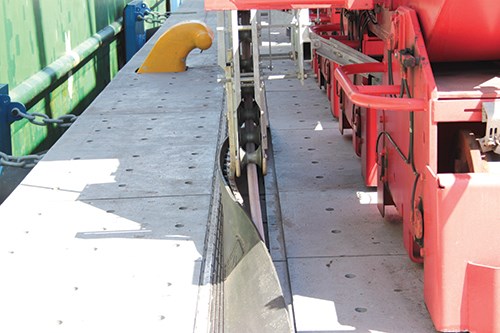Quay cable tray: Composites upgrade container ship terminal
When the Cape Town, South Africa, Transnet National Ports Authority began a 12-month effort to expand its facility and upgrade its existing quays (wharfs), engineers realized that the Authority had a safety problem at its main container quay. Composites provided the solution.
In South Africa, the Transnet National Ports Authority of Cape Town operates a busy port with considerable container ship traffic. When it began a 12-month effort with a local civil engineering company to expand its facility and upgrade its existing quays (wharfs), engineers realized that the Authority had a safety problem at its main container quay: A raised cable tray runs along the quay’s edge. More than 1,200m/3,900 ft long and 3m/10 ft wide, the tray contains the electrical cables that power the large, rail-mounted gantry cranes used to load and unload ships. The tray was a serious trip hazard for workers. In search of a safer solution, the engineering company approached Cape Town-based composite materials supplier and distributor AERONTEC cc.
“Engineers had considered pouring a concrete layer at 190 mm [7.5 inches] thick to bring the quay edge level with the cable tray and the crane rail,” says Graham Blyth, Aerontec’s owner. But that solution weighed in at about 1,000 tons, he recalls. The quay’s cantilevered deck and supporting piles weren’t designed to carry the additional weight. Further, he notes, the concrete’s “28-day cure time would have interfered with berthing ships.”
The cable tray problem needed a solution that would be not only light in weight, but also provide safe footing and permit access to existing manholes and fire hydrants, yet be cost-effective and easy to install. The Ports Authority further specified that any seawater that might wash over the installation should drain away quickly, with minimal corrosion. Perhaps the toughest requirement, however, was that the solution should be strong enough to bear loads of up to 36.3 metric tonnes (80,028 lb) in the event a shipping container is placed, or dropped, within the cable tray area. Finally, the structure should be replaceable, if damaged, and prevent damage to the quay’s underlying concrete surface.
An iterative design and testing process resulted in large, monolithic resin-infused, fiberglass-reinforced polymer (FRP) panels. The 32-mm/1.5-inch thick slabs, formed from woven glass roving and isophthalic polyester resin, were coated with a UV-stabilized iso-NPG (neopentyl glycol) and a nonslip grip finish and drilled to create drainage holes. The reinforcement was woven to Aerontec’s specification and supplied by Vision Composites (Winchester, U.K.) The resin, gel coat and flow-coating materials were sourced from two suppliers: NCS Resins (Pinetown, South Africa) and Scott Bader Company Ltd.(Northamptonshire, U.K.). Aerontec partnered with composites fabricator MMS Technology (Centurion, South Africa) to manufacture and waterjet cut 1,161 panels of varying sizes, which were numbered for installation. Blyth explains that each panel was raised to the specified height using stepped solid feet, bonded to the panel underside; the stepped feet were cored with a vertical pultruded FRP rod. “The quay varies 80 mm [3.2 inches] in height over its surface,” he points out. “We needed to be virtually level with the crane rail to eliminate any trip hazard, so we bonded GFRP shims to the stepped feet to keep the panels level,” he adds.
Some panels required cutting to accommodate the quay bollards (thick, yellow curved posts in photos), and in other panels, openings were cut and fitted with hinged lids for manhole/fire hydrant access. A 300-mm/12-inch gap was left between the panels adjacent to the crane rail and the panels at the water’s edge, to accommodate the crane’s electrical cables. A stiff rubber “Panzer” belt covers the gap, and the cranes are fitted with onboard lifters that bend the belt up out of the way as the crane rolls through on the rails (see the middle photo).
The total weight of all the composite panels was just 226 metric tonnes (500,000 lb) — within the quay’s weight constraint — and the entire project was completed on schedule and within budget.
“As far as I know, this is the first time a project of this type has ever been undertaken in the world,” concludes Blyth. “And I believe it was also the biggest single composites job ever completed in South Africa.”
Related Content
GKN Aerospace, Joby Aviation sign aerostructures agreement
GKN Aerospace will manufacture thermoplastic composite flight control surfaces for Joby’s all-electric, four-passenger, composites-intensive ride-sharing aircraft.
Read MorePEEK vs. PEKK vs. PAEK and continuous compression molding
Suppliers of thermoplastics and carbon fiber chime in regarding PEEK vs. PEKK, and now PAEK, as well as in-situ consolidation — the supply chain for thermoplastic tape composites continues to evolve.
Read MorePlant tour: Albany Engineered Composites, Rochester, N.H., U.S.
Efficient, high-quality, well-controlled composites manufacturing at volume is the mantra for this 3D weaving specialist.
Read MoreBladder-assisted compression molding derivative produces complex, autoclave-quality automotive parts
HP Composites’ AirPower technology enables high-rate CFRP roof production with 50% energy savings for the Maserati MC20.
Read MoreRead Next
Developing bonded composite repair for ships, offshore units
Bureau Veritas and industry partners issue guidelines and pave the way for certification via StrengthBond Offshore project.
Read MoreVIDEO: High-volume processing for fiberglass components
Cannon Ergos, a company specializing in high-ton presses and equipment for composites fabrication and plastics processing, displayed automotive and industrial components at CAMX 2024.
Read More“Structured air” TPS safeguards composite structures
Powered by an 85% air/15% pure polyimide aerogel, Blueshift’s novel material system protects structures during transient thermal events from -200°C to beyond 2400°C for rockets, battery boxes and more.
Read More

























